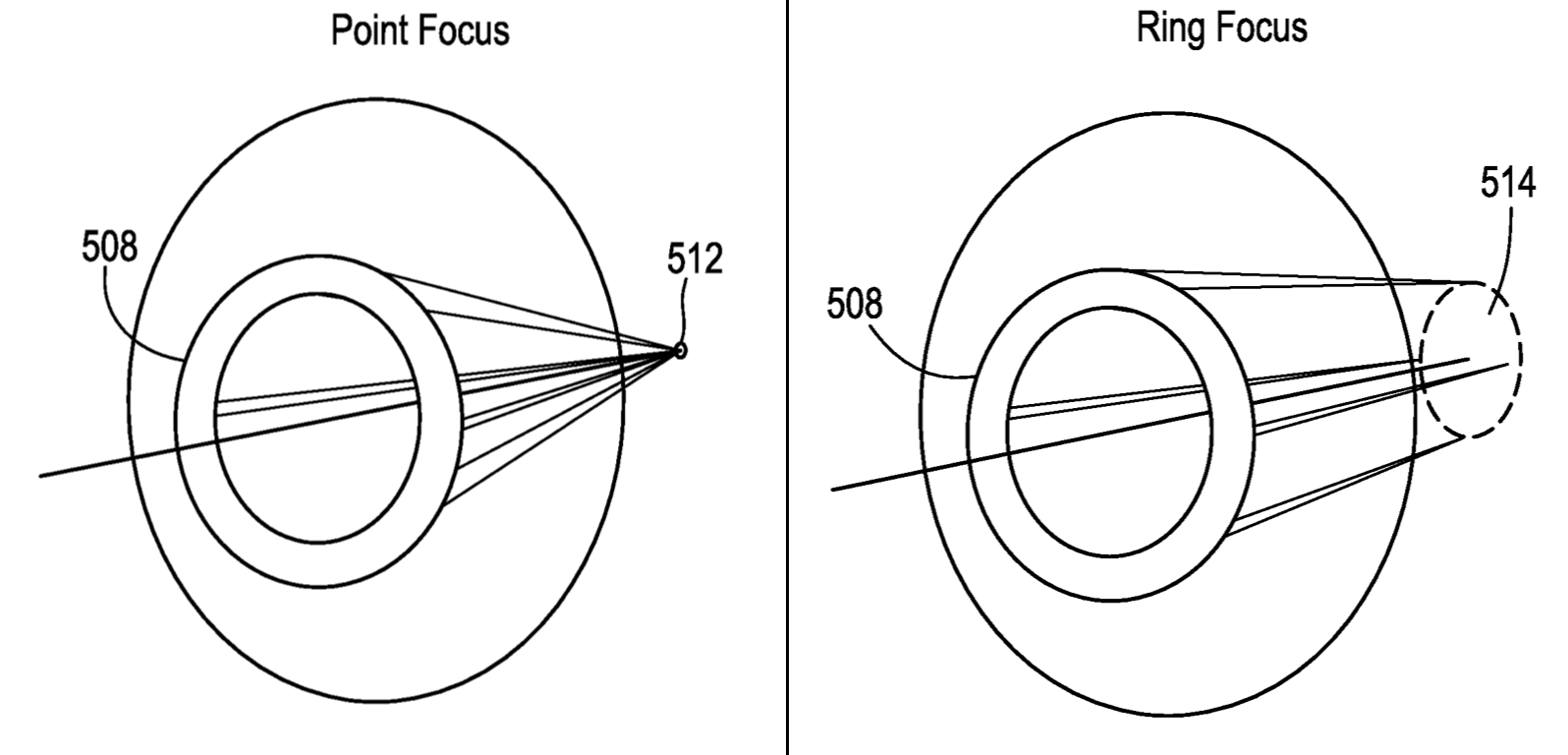 |
|
This study, funded by J&J, touts the advantage of optics that create a ring focus (right) rather than the point focus (left) of existing lenses. The company’s prototype soft contact lens for myopia has a more significant effect on slowing disease progression than single-vision or dual-focus lenses, according to the study. Photo: Johnson & Johnson. Click image to enlarge. |
Myopia is a longstanding hot topic in eye care as the fastest-growing vision condition worldwide. Researchers are continually proposing new techniques such as novel contact lens designs that aim to reduce axial elongation, with varying levels of success. Most contact lenses for controlling myopia work by increasing add power in the lens treatment zone, thereby introducing myopic defocus in the visual field. However, increasing add power beyond a certain range has the potential to degrade a patient’s vision in the long term, placing a limit on the use and efficacy of these types of lenses.
Hoping to develop a method for myopia control that also helps preserve visual performance, Johnson & Johnson Vision recently began investigating soft contact lens prototypes featuring what the company describes as a “ring-focus design.”
Unlike existing multifocal or dual-focus designs, the plus power in the prototype lenses is created without generating a coaxial point focus, explains a new report on the work published in Ophthalmology Science.1 “Rays passing through concentric annular zones of the prototype lenses form a ring focus in front of the retina,” the developers explain in their article. “The dispersal of these rays is such that the impact on vision can be modulated compared to existing coaxial multifocal designs, while still allowing control of myopia progression.”
In a patent filing, the company asserts that “the significant benefit of such design is that visual acuity is less affected, interference with normal accommodation is minimized, and the halo effect is reduced. A larger treatment zone area and higher add power may be utilized as a result.”2
To test the trade-off between myopia reduction efficacy and quality of vision, the company developed two test lenses: one designed to enhance efficacy (EE) and the other to enhance vision (EV).
“EE was designed to increase myopia control efficacy via the introduction of a greater amount of plus power than conventional multifocal or dual-focus lens designs while maintaining comparable visual performance,” the researchers wrote. “EV was designed to optimize vision while maintaining similar myopia control efficacy to a standard dual-focus lens. Both lenses include two concentric, annular zones with +7D non-coaxial plus power for myopia control treatment, but these annular treatment zones in the EE lens are positioned closer to the center of the lens than for EV. EE also includes a +10D coaxial treatment zone that was designed to further ‘boost’ myopia control efficacy while limiting its impact on vision.”
The team reported on a study, funded by J&J, comparing the efficacy of the two prototypes with a dual-focus multifocal (in effect, the benchmark for myopia control) and a single-vision lens (the benchmark for visual quality). The study evaluated 185 patients wearing the various lens designs over the course of 26 weeks (n=44, 49, 45 and 47 for EE, EV, dual-focus and single-vision, respectively). No adverse events occurred in any of the groups.
Patients wearing EE, EV or dual-focus lenses all had significantly less axial elongation than those wearing single-vision lenses (EE: 0.08mm, EV: 0.12mm, DF: 0.14mm, SV: 0.19mm). Both EE and EV lenses resulted in less axial elongation than dual-focus lenses, but only the difference between EE and dual-focus lenses was statistically significant (-0.049mm).
When comparing EE and single-vision lenses, the study authors reported that EE alone had significantly less progression of spherical equivalent autorefraction than single-vision (-0.12D vs. -0.35D). When comparing this same parameter in EV vs. dual-focus lenses, no difference was shown.
The authors concluded from their research on the lens prototypes that “EE was more efficacious in slowing axial elongation than dual-focus with comparable vision performance, while EV produced comparable efficacy to dual-focus with similar vision performance to single-vision.”
Looking forward, the researchers argue that lenses with a non-coaxial ring-focus design might “offer an alternative approach [for myopia control] with potential to mitigate some of the limitations of conventional presbyopic coaxial principles.” They suggest that the EE soft contact lens be investigated in future studies as a viable candidate for pediatric myopia control.
Last year, Johnson & Johnson launched in Canada a soft lens for myopia control using this system of optics, called Acuvue Abiliti 1-Day. The company currently anticipates a US launch sometime in 2024. The commercial product in the Canadian market is indicated for children aged seven to 12 with myopia between -0.75D and -4.50D and 1.00D or less of astigmatism.
1. Cheng X, Xu J, Brennan NA. Randomized trial of soft contact lenses with novel ring focus for controlling myopia progression. Ophthalmology. October 18, 2022. [Epub ahead of print]. 2. Brennan NA, Cheng X, Hernandez JV, et al. Ophthalmic lens with an optically non-coaxial zone for myopia control. Assignee: Johnson & Johnson. 2021. US Patent No. 10901237. |


